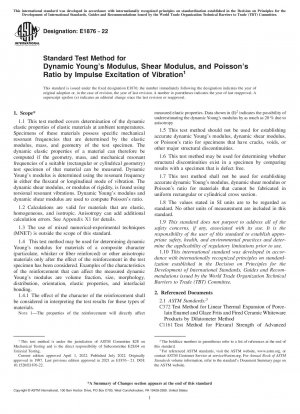ASTM E1876-22
Standard Test Method for Dynamic Young's Modulus, Shear Modulus, and Poisson's Ratio by Impulse Excitation of Vibration
- Standard No.
- ASTM E1876-22
- Release Date
- 2022
- Published By
- American Society for Testing and Materials (ASTM)
- Latest
- ASTM E1876-22
- Scope
- 1.1 This test method covers determination of the dynamic elastic properties of elastic materials at ambient temperatures. Specimens of these materials possess specific mechanical resonant frequencies that are determined by the elastic modulus, mass, and geometry of the test specimen. The dynamic elastic properties of a material can therefore be computed if the geometry, mass, and mechanical resonant frequencies of a suitable (rectangular or cylindrical geometry) test specimen of that material can be measured. Dynamic Young’s modulus is determined using the resonant frequency in either the flexural or longitudinal mode of vibration. The dynamic shear modulus, or modulus of rigidity, is found using torsional resonant vibrations. Dynamic Young’s modulus and dynamic shear modulus are used to compute Poisson’s ratio. 1.2 Calculations are valid for materials that are elastic, homogeneous, and isotropic. Anisotropy can add additional calculation errors. See Appendix X1 for details. 1.3 The use of mixed numerical-experimental techniques (MNET) is outside the scope of this standard. 1.4 This test method may be used for determining dynamic Young’s modulus for materials of a composite character (particulate, whisker or fiber reinforced) or other anisotropic materials only after the effect of the reinforcement in the test specimen has been considered. Examples of the characteristics of the reinforcement that can affect the measured dynamic Young’s modulus are volume fraction, size, morphology, distribution, orientation, elastic properties, and interfacial bonding. 1.4.1 The effect of the character of the reinforcement shall be considered in interpreting the test results for these types of materials. NOTE 1—The properties of the reinforcement will directly affect measured elastic properties. Data shown in (1)2 indicates the possibility of underestimating the dynamic Young’s modulus by as much as 20 % due to anisotropy 1.5 This test method should not be used for establishing accurate dynamic Young’s modulus, dynamic shear modulus, or Poisson’s ratio for specimens that have cracks, voids, or other major structural discontinuities. 1.6 This test method may be used for determining whether structural discontinuities exist in a specimen by comparing results with a specimen that is defect free. 1.7 This test method shall not be used for establishing accurate dynamic Young’s modulus, dynamic shear modulus or Poisson’s ratio for materials that cannot be fabricated in uniform rectangular or cylindrical cross section. 1.8 The values stated in SI units are to be regarded as standard. No other units of measurement are included in this standard. 1.9 This standard does not purport to address all of the safety concerns, if any, associated with its use. It is the responsibility of the user of this standard to establish appropriate safety, health, and environmental practices and determine the applicability of regulatory limitations prior to use. 1.10 This international standard was developed in accordance with internationally recognized principles on standardization established in the Decision on Principles for the Development of International Standards, Guides and Recommendations issued by the World Trade Organization Technical Barriers to Trade (TBT) Committee.
ASTM E1876-22 Referenced Document
- ASTM C1161 Standard Test Method for Flexural Strength of Advanced Ceramics at Ambient Temperature
- ASTM C1198 Standard Test Method for Dynamic Young's Modulus, Shear Modulus, and Poisson's Ratio for Advanced Ceramics by Sonic Resonance
- ASTM C372 Standard Test Method for Linear Thermal Expansion of Porcelain Enamel and Glaze Frits and Fired Ceramic Whiteware Products by Dilatometer Method
- ASTM E177 Standard Practice for Use of the Terms Precision and Bias in ASTM Test Methods
- ASTM E6 Standard Terminology Relating to Methods of Mechanical Testing
ASTM E1876-22 history
- 2022 ASTM E1876-22 Standard Test Method for Dynamic Young's Modulus, Shear Modulus, and Poisson's Ratio by Impulse Excitation of Vibration
- 2021 ASTM E1876-21 Standard Test Method for Dynamic Young's Modulus, Shear Modulus, and Poisson's Ratio by Impulse Excitation of Vibration
- 2015 ASTM E1876-15 Standard Test Method for Dynamic Young's Modulus, Shear Modulus, and Poisson's Ratio by Impulse Excitation of Vibration
- 2009 ASTM E1876-09 Standard Test Method for Dynamic Young''s Modulus, Shear Modulus, and Poisson''s Ratio by Impulse Excitation of Vibration
- 2007 ASTM E1876-07 Standard Test Method for Dynamic Young''s Modulus, Shear Modulus, and Poisson''s Ratio by Impulse Excitation of Vibration
- 2001 ASTM E1876-01(2006) Standard Test Method for Dynamic Young''s Modulus, Shear Modulus, and Poisson''s Ratio by Impulse Excitation of Vibration
- 2001 ASTM E1876-01 Standard Test Method for Dynamic Young's Modulus, Shear Modulus, and Poisson's Ratio by Impulse Excitation of Vibration
- 2000 ASTM E1876-00 Standard Test Method for Dynamic Young's Modulus, Shear Modulus, and Poisson's Ratio by Impulse Excitation of Vibration
- 1999 ASTM E1876-99 Standard Test Method for Dynamic Young's Modulus, Shear Modulus, and Poisson's Ratio by Impulse Excitation of Vibration
